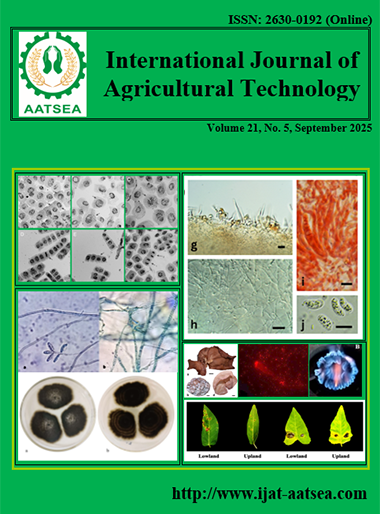New natural dyes from red prickly pear produced by addition of metal ions and their application in textile.
Main Article Content
Abstract
Sicily produces 94% of Italy's farmed crops. The tropical or subtropical plant Opuntia ficus-indica (L.) Mill. is cultivated in regions such as the Mediterranean and Central America is used to make the natural dye from the fruits of red prickly cactus pear trees. Where it constructs a good source for food. Betaline pigment extracted and used for synthesis of three new metal complex dyes by addition of bivalent metal ions as copper, cobalt and nickel. These dyes are used for dyeing wool fibers using microwave heating and conventional technique Investigations were conducted into the characteristics of the dyed wool fibers, including dye concentration, pH, color strength, color data, and fastness. The results demonstrated that wool fibres have good colour strength and fastness characteristics. The antibacterial action against a few harmful bacteria and fungus was indicated that the antimicrobial activity of the natural dyes was good results. The metal complex dyes from betaline extracted from red prickly were actively against Staphylococcus aureus, Pseudomonas aeruginosa, Aspergillus niger and Escherichia coli.
Article Details

This work is licensed under a Creative Commons Attribution-NonCommercial-NoDerivatives 4.0 International License.
References
Ali, N. F. and Abd- Elsalam, I. S. (2020). Antimicrobial characteristics of wool fibers treated with chitosan-propolis nano composite and dyed with natural dye extracted from Red Prickly Pear. International Journal of Agricultural Technology, 16:223-236.
Ali, N. F. and El- Khatib, E. M. (2010). Modification of wool fabric to improve its dyeability. Journal of Natural Fiber, 7:276-288.
Ali, N. F. and El-Mohamedy, R. S. R. (2011). Eco-friendly and protective natural dye from red prickly pear (Opuntia lasiacantha Pfeiffer) plant. Journal of Saudi Chemical Society, 15:257-261.
Ali, N. F., El-Khatib, E. M., El-Mohamedy, R. S. R., Nassar, S. H. and El-Shemy, N. S. (2019). Dyeing properties of wool fibers dyed with rhubarb as natural dye via ultrasonic and conventional methods. Egyptian Journal of Chemistry, 62:119-130.
Ben-David, A. and Davidson, C. E. (2014). Estimation method for serial dilution experiments. Journal of Microbiological Methods, 107:214-221.
Dhanalakshmi, M., Thenmozhi, S., Manjula Devi, K. and Kameshwarm, S. (2013). Silver nanoparticles and its antibacterial activity. nternational Journal of Pharmaceutical & Biological Archives, 4:819-826.
Fernandes Júnior, A., Balestrin, E. C., Betoni, J. E. C., Orsi, R. D. O., Cunha, M. D. L. R. D. and Montelli, A. C. (2005). Propolis: Anti-Staphylococcus aureus activity and synergism with antimicrobial drugs. Memórias do Instituto Oswaldo Cruz, 100: 563-566.
Fernandez-Lopez, J. A. and Almela, L. (2001). Application of high-performance liquid chromatography to the characterization of thebetalain pigments in prickly pear fruits. Journal of Chromatography, 913:415-420.
Iswariya, S., Clara Dhanemozhi, A. and Yugamica, S. (2017). Synthesis and characterization of dye sensitized solar cell using fruit extracts. International Research Journal of Engineering and Technology, 4:277-285.
Kanner, J., Harel, S. and Granit, R. (2001) Betalains-A new class of dietary cationized antioxidants. Journal of Agricultural and Food Chemistry, 4:5178-5185.
Pigi, A., Del Caro, A., Pinna, I. and Agabbio, M. (2003). Changes in ascorbic acid, polyphenol content and antioxident activity in minimally processed cactus pear fruits. Lebensmittel-Wissenschaft under Technologie, 36:257-262.
Prabu, K. M. and Anbarasan, P. M. (2014). Improved performance of natural dye sensitized solar cells (NDSSCS) using ZnO doped TiO2 nanoparticles by sol-gel method. International Journal of Science and Research, 3:1740-1747.
Rajendhiran, R., Raji, A., Jayabal, P., Balasankar, A., Tae Hwan, O., Deivasigamani, V. and Ramasundaram, S. (2023). Prickly pear fruit extract: capping agent for the Sol–Gel synthesis of discrete titanium dioxide nanoparticles and sensitizer for dye-sensitized solar cell. Coatings, 13:579.
Stintzing, F. C., Herbach, K. M., Mosshammer, R. M., Carle, R., Yi, W., Sellappan, S., Akoh, C. C., Bunch, R. and Felker, P. (2005). Color, betalain pattern, and antioxidant properties of cactus pear (Opuntia spp.) clones. Journal of Agricultural and Food Chemistry, 53:442-451.
Wink, M. (2008). Evolutionary advantage and molecular modes of action of multi-component mixtures used in phytomedicine. Current Drug Metabolism, 9:996-1009.
Wink, M. (2015). Modes of action of herbal medicines and plant secondary metabolites. Medicines, 2:251-286.


